Project
Optimization of Sphagnum paludicultures

Interaction of climate change, nutrient input and peat properties – optimization of Sphagnum paludicultures under challenging conditions
How can we successfully establish and optimize Sphagnum paludicultures even under challenging conditions?
Background and Objective
The majority of peatlands in Germany has been drained for agriculture, forestry and peat extraction and thus emits large quantities of greenhouse gases (GHG). One possibility to reduce the GHG emissions is “paludiculture”, i.e. agriculture or forestry under quasi-natural hydrological conditions. In the case of bogs, the cultivation of Sphagnum mosses is the major option as Sphagnum can be used as high-quality horticultural substrate [link].
However, there is a number of challenges for Sphagnum paludicultures: Due to climate change, higher temperatures and lower precipitation in summer cause higher evapotranspiration rate and lower groundwater levels. This will reduce moss growth and promote the invasion of vascular plants such as Molinia caerulea and Betula pubescens. The effects of higher temperatures on the exchange of carbon dioxide (CO2) and methane (CH4) are still ambiguous.
At the same time, vascular plants with aerenchymous tissue increase CH4 emissions. Although they might be beneficial for Sphagnum growth due to shading effects, they will increase evapotranspiration. Furthermore, the will decrease substrate quality of the mosses and thus increase maintenance costs. Another important factor is the high nitrogen deposition especially into north-western German bogs. This might both influence Sphagnum and vascular plant growth as well as GHG exchange.
All these challenges are especially difficult in the case of strongly decomposed peat. Strongly decomposed peat remains after peat extraction or due to drained of peatlands under agriculture and has highly unfavourably soil hydraulic properties, which will amplify problems such as water deficiency. The interaction of these factors has, however, not yet been systematically investigated.
The overarching goal of this project is an improved understanding – and thus an improved management – of Sphagnum paludicultures under difficult conditions regarding climate, nutrient deposition and peat properties. Results of this projects might be transferred to challenges in “classical” bog restoration.
Approach
Since 2015, we participate in a large-scale field trial of Sphagnum cultivation on strongly decomposed peat [link]. Here, we will partly continue with the measurement of the GHG exchange to cover a whole production cycle including harvest and post-harvest regeneration. The exchange of CO2, CH4 and nitrous oxide (N2O) is measured manually with chambers. Apart from this, we monitor meteorological and hydrological parameters and determine the vegetation composition.
Additionally, we will conduct a full-factorial greenhouse experiments using soil columns with both weakly and strongly decomposed peat. After establishing hummock Sphagnum species, we will apply seeds of vascular plants and vary temperature, water level and nitrogen input. During the experiment, CO2 and CH4 exchange will be measured, water samples will be analysed and seedlings counted. A process-based model will be used to improve our understanding of the dependency of growth and survival on environmental parameters.
Our Research Questions
- What is the GHG balance of a whole production cycle of a Sphagnum paludiculture including the post-harvest regeneration phase?
- How do vascular plants, nutrient supply, peat type, water level and temperature control the CO2 and CH4 exchange of Sphagnum paludicultures?
- How do water level, nutrient supply and temperature effect the seedling survival rate and the growth of vascular plants as well as the growth and substrate quality of Sphagnum?
Thünen-Contact

Involved Thünen-Partners
Duration
8.2019 - 7.2023
More Information
Project status:
finished

![[Translate to English:] [Translate to English:]](/media/_processed_/6/4/csm_titel_CO2Kampagne8_afeea2273e.png)
![[Translate to English:] [Translate to English:]](/media/_processed_/4/1/csm_titel_93px_CO2Kampagne8_9b0f3354d4.png)





